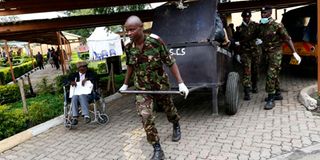Get local builder for military hospital

Cadets from the Kenya Military Academy in Lanet, Nakuru carry out general cleaning activities during their community service day at the Nakuru Level 5 Hospital in this picture taken on June 22, 2016.
What you need to know:
- The appetite by Chinese companies for building and equipping large hospitals came to the fore in 2014.
- Admittedly, the Defence ministry has made a fairly persuasive case for the project.
It seems that, despite the loud noises we have been making in the press about runaway external debt situation in the country, in spite of the recent public outrage about rapid accumulation of expensive loans on the government’s external debt ledger, the Jubilee administration’s huge appetite for Chinese loans is still growing.
The government plans to build a massive 700-bed fully equipped military referral hospital at Kabete Barracks on Nairobi’s Waiyaki Way that is to be funded by money borrowed from an export credit agency. When you borrow from an export credit agency, the contractor to build and equip the hospital must come from the country you borrow from.
Last week, the Ministry of Defence sent out a restricted tender inviting contractors to submit bids and proposals. The deadline for tender submissions set for March 21, 2021. The tender documents explain that this will be an “engineering, procurement contract (EPC)”, funded by an export credit agency. To eliminate jokers, the conditions for winning the tender have been made stiff.
The contractor must have an annual construction turnover of more than Sh20 billion for the past four years. You must have completed a similar project of a value of at least Sh2 billion in the past 10 years. The lead architect must have been involved in the design of at least one hospital project valued at over Sh1 billion in the past decade.
When you look at it closely, it is as if these conditions have been crafted to set the stage for dominance by Chinese EPC contractors. Where else can you get construction companies in this country with the experience, technical and financial capacity to build and equip such a big hospital?
Chinese export credit agencies — especially China Exim Bank — is unrivalled when it comes to mobilising financing for such projects. Here are a few examples: The 650-bed Kenyatta University Referral Hospital, the largest greenfield hospitals to be constructed in this country in recent years, was built and equipped by the EPC contractor China Jianxi with funding from China Exim Bank. We will be repaying this loan until March 2031.
Chinese contractor
The 250-bed Mama Lucy Kibaki Hospital in Kayole, Nairobi, was also built and equipped by yet another Chinese EPC contractor, China Wu Yi, from a grant from the Chinese government.
The appetite by Chinese companies for building and equipping large hospitals came to the fore in 2014, when it was revealed in Parliament that China Wu Yi had engaged local powerbrokers to lobby for a multi-billion-shilling deal to expand and equip Moi Referral and Teaching Hospital, Eldoret.
Clearly, Chinese contractors rule the roost when it comes to construction of large turnkey projects. I predict that the military hospital project will go to a Chinese contractor.
Predictably, this project will force us to take a massive loan. The Kenyatta University hospital made us to take a Sh744 million yuan ($114 million, or Sh11.4 billion) loan from China Exim Bank on terms far inferior to those that you get when you borrow from institutions such as the International Development Association (IDA) of the World Bank.
Admittedly, the Defence ministry has made a fairly persuasive case for the project. With the increase in operations by Kenya’s security forces, the case for enhancing capacity in medical and surgical care in security health installations cannot be gainsaid. The Forces Memorial Hospital, Nairobi, is the sole referral hospital for security forces in the country.
Where I disagree is the idea of funding it through a Chinese export credit agency. If it must happen, let us look for the money from our own sources and open the project to international competitive bidding.
Loans from China
There are solid economic arguments for opposing borrowing from export credit agencies. President Mwai Kibaki succeeded because most of the money spent on infrastructure and other brick and mortar projects was from local sources.
Loans from China mostly come in kind. And since most of it does not come to Kenya and is paid directly to foreign accounts of Chinese companies, the multiplier effect of this kind of spending on our macro economy is minimal.
It was the former governor of the Bank of Tanzania, the late Bennon Ndulu, who argued that the macro economy of East Africa had suffered from a sharp decline in “liquidity-injecting financing” as countries had taken too many loans from Chinese export credit agencies.
Prof Nduku argued that when Chinese banks dominate infrastructure projects, the macro economy suffers huge leakages in multiplier effects, especially as most of the imported materials for Chinese-funded projects are duty- and tax-exempt.
In the Kibaki era, we witnessed an unprecedented increase in revenue collection, low interest rates and spectacular growth, especially during the early years of his first term. I repeat: We must tone down our appetite for Chinese loans.





